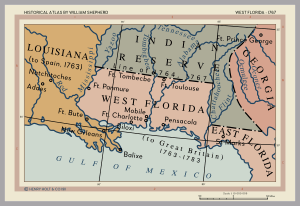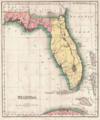Spanish West Florida facts for kids
Quick facts for kids Province of West Florida |
|||||||||
|---|---|---|---|---|---|---|---|---|---|
| Province of Viceroyalty of New Spain | |||||||||
| 1783–1821 | |||||||||
 |
|||||||||
| Capital | Pensacola | ||||||||
| Government | |||||||||
| • Type | Colonial government | ||||||||
| Governor | |||||||||
|
• 1783–1792
|
Arturo O'Neill de Tyrone | ||||||||
|
• 1819–1821
|
José María Callava | ||||||||
| History | |||||||||
| 10 February 1783 | |||||||||
|
• Disestablished
|
1821 | ||||||||
|
|||||||||
Spanish West Florida (in Spanish: Florida Occidental) was a special area, or province, ruled by the Spanish Empire. This lasted from 1783 until 1821. After that, it became part of the United States along with East Florida. This change happened because of a deal called the Adams–Onís Treaty.
This area, known as West Florida, first had the same boundaries as the old British colony. Over time, the United States slowly took over much of its land. At its largest, Spanish West Florida included parts of what are now Louisiana, Mississippi, Alabama, and the Panhandle of Florida. Areas like southeastern Louisiana and coastal Mississippi and Alabama were taken by the U.S. during or before the War of 1812. The land that is now Florida was acquired later. It became the Florida Territory of the United States in 1822.
How West Florida Became Spanish Again
Spain was the first European country to settle in the Florida area. They moved north from Cuba. They built lasting towns like St. Augustine on the Atlantic Ocean coast. They also built Pensacola and San Marcos (St. Marks) on the Gulf of Mexico coast.
-
Under Spanish rule, Florida was split by the Suwannee River into West Florida and East Florida (map: Carey & Lea, 1822).
From British to Spanish Control
After Spain lost to Great Britain in the Seven Years' War, Spain gave its Florida land to Britain in 1763. British leaders then split the area into two colonies. These were East Florida (with its capital at St. Augustine) and West Florida. West Florida also included land Britain got from France in the 1763 peace treaty. West Florida stretched from the Apalachicola River to the Mississippi River. Its capital was Pensacola.
In 1779, Spain joined the American Revolutionary War. They sided with France, but not with the Thirteen Colonies. Bernardo de Gálvez, who was the governor of Spanish Louisiana, led a military effort along the Gulf coast. He captured Baton Rouge and Natchez from the British in 1779. He also took Mobile in 1780 and Pensacola in 1781.
In the 1783 Paris peace treaty, Great Britain gave both Florida colonies back to Spain. Spain decided not to manage Florida as one big area, as it had before 1763. Instead, New Spain kept the British way of dividing the land into East and West Florida (Florida Oriental and Florida Occidental). When Spain got West Florida in 1783, its eastern border was the Apalachicola River. But Spain moved it east to the Suwannee River in 1785. This was to move San Marcos and the Apalachee district from East Florida to West Florida.
Who Lived in West Florida?
When British West Florida became Spanish, people living in Pensacola could choose to stay or leave. Most people chose to leave. Pensacola was mainly a British military base. Most people there worked for or were connected to the military. When Spain took over, about 300 civilians lived in Pensacola, not counting the soldiers.
The number of people in Pensacola grew. In 1788, there were 265 civilians. By 1791, this number grew to 572. However, when Spain went to war in April 1793, some people left. This made the population drop to 400. After Spain lost Spanish Louisiana, the population grew again to 1,000 by 1810. It reached its highest point of 3,063 people in a count taken on June 13, 1813.
Between Pensacola and the American settlements, several Native American tribes lived. These included the Cherokee, Chickasaw, Choctaw, and Creek. Together, their population was about 45,000 people.
When the Spanish arrived in West Florida, they did not bring back the mission system. They had left this system behind when the British took control in 1763. The Spanish allowed people to have religious freedom in their homes. However, they did not let people practice any religion other than Roman Catholicism in public.
The Spanish helped the French Acadians move to the bayou areas of Louisiana. They helped pay for their travel, living costs, and gave them money between 1783 and 1785. Their move to Louisiana led to the creation of the Cajun culture.





